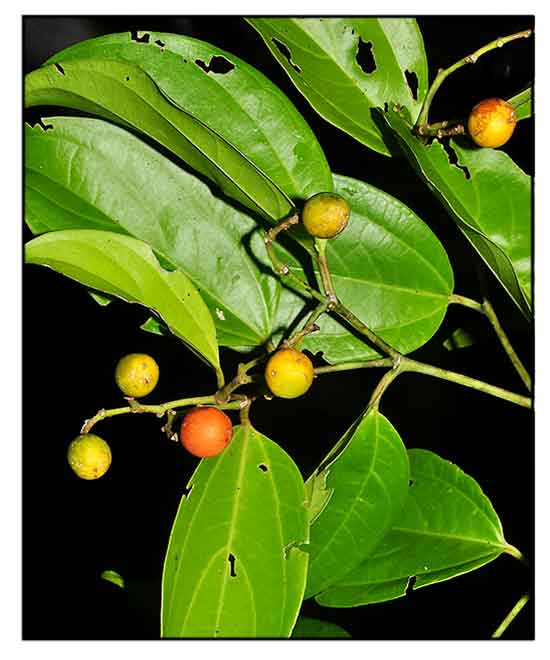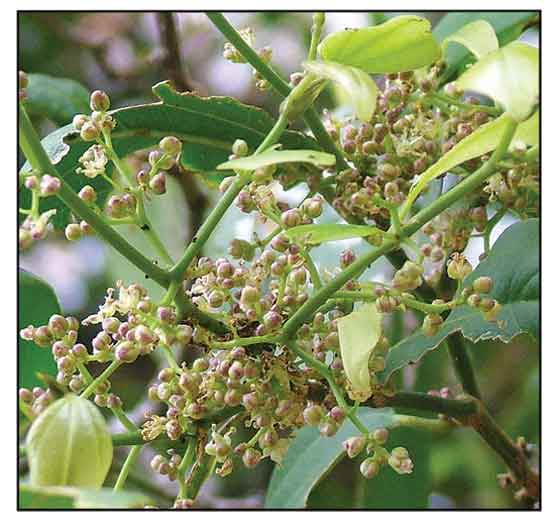
Family • Cannabaceae
Malaikmo
Celtis philippensis Blanco
CELTIS
Da guo you po
| Scientific names | Common names |
| Bosea trinervia Roxb. | Hapi-hapi (Ayangan) |
| Celtis brevinervis (Blume) Planch. | Magabuyo (Tag.) |
| Celtis collinsiae Craib | Malaikmo (Tagalog) |
| Celtis djungiel (Blume) Planch. | Maragaoed (Iloko) |
| Celtis hasseltii (Blume) Planch. | Maragawed (Iloko) |
| Celtis laurifolia (Blume) Planch. | Narabagsay (Tagalog) |
| Celtis mindanaensis Elmer | Celtis (Trade name) |
| Celtis multifolia Elmer ex. Merr. | Wight's hackberry (Engl.) |
| Celtis philippensis Blanco | Wight's nettle tree (Engl.) |
| Celtis philippensis var. consimilis J.F.Leroy | |
| Celtis philippensis var. wightii (Planch.) Soepadmo | |
| Celtis trinervia (Roxb.) Koord. | |
| Celtis wightii Planch. | |
| Celtis wightii var. consimilis (Blume) Gagnep. | |
| Solenostigma brevinerve Blume | |
| Solenostigma consimile Blume | |
| Solenostigma djungiel Blume | |
| Solenostigma hasseltii Blume | |
| Solenostigma laurifolium Blume | |
| Solenostigma wightii Blume | |
| Sponia strychnifolia Teijsm. & Binn. | |
| Celtis philippensis Blanco is an accepted species. KEW: Plants of the World Online | |
| Other vernacular names |
| CHINA: Da guo you po. |
| INDIA: Korlumuruka maram, Vaelagatha maram (Irula), Bhoothakkali, Bhutha, Butha, Kalluveera, Manalli, Peenari, Vellakkuyyan (Malayalam), Ellumbiruthi, Kalluviri, Kodaalimuriki, Pinari, Vellai thovarai (Tamil), Korlumuruka maram, Vakkanai. |
| INDONESIA: Ki endog (Sundanese), Penjalinan sentok (Javanese) |
| MALAYSIA: Nyelepi (Sabah). |
| SINHALA: Medithella. |
| THAILAND: Thalai khao. |
| OTHERS: Pisie, Kayoe lielien. |
Botany Distribution
Properties Studies Availability |
November 2023
![]()
 |
| PHOTOS / ILLUSTRATIONS |
| IMAGE SOURCE: Cannabaceae : Celtis philippensis / Fruiting twig / Copyright © 2011 by Leonardo L Co [ref. DOL30999] / Non-Commercial Use / image modified / click on image or link to go to source page / Phytoimages.siu.edu |
| OTHER IMAGE SOURCE: Cannabaceae : Celtis philippensis / Fruiting twig / Copyright © 2011 by Leonardo L Co [ref. DOL35714] / Non-Commercial Use / image modified / click on image or link to go to source page / Phytoimages.siu.edu |
| OTHER IMAGE SOURCE: Cannabaceae : Celtis philippensis Wightii (Planch.) E.Soepadmo / Leaf (lower side) / Copyright © The Biotik Team, French Institute of Pondicherry / CC_SA / Non-Commercial Use / image modified / click on image or link to go to source page / India Biodiversity Portal |
| OTHER IMAGE SOURCE: Cannabaceae : Celtis philippensis Wightii (Planch.) E.Soepadmo / Copyright © Keystone Foundation / CC_SA / Non-Commercial Use / image modified / click on image or link to go to source page / India Biodiversity Portal |
Additional
Sources and Suggested Readings |
• |
DOI: It is not uncommon for links on studies/sources to change. Copying and pasting the information on the search window or using the DOI (if available) will often redirect to the new link page. (Citing and Using a (DOI) Digital Object Identifier) |
| List of Understudied Philippine Medicinal Plants |
| New plant names needed The compilation now numbers over 1,400 medicinal plants. While I believe there are hundreds more that can be added to the collection, they are becoming more difficult to find. If you have a plant to suggest for inclusion, native or introduced, please email the info: scientific name (most helpful), local plant name (if known), any known folkloric medicinal use, and, if possible, a photo. Your help will be greatly appreciated. |
• |
 |




 Uses
Uses